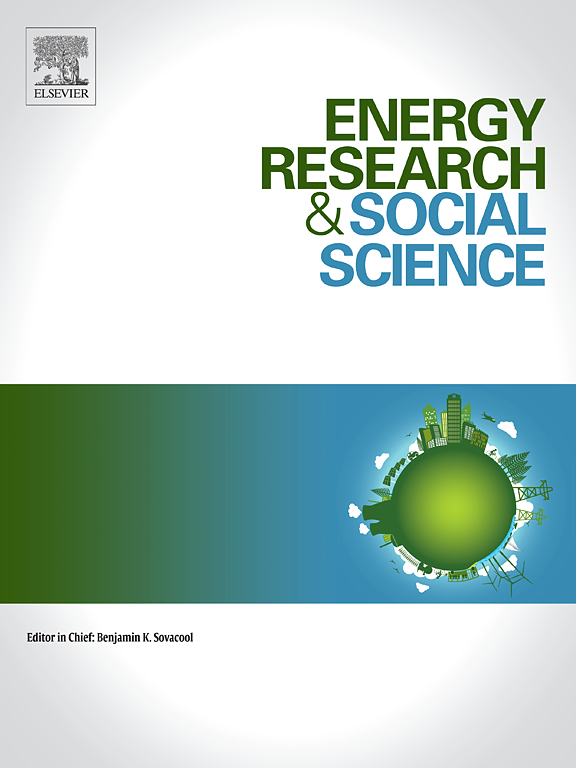Household carbon caps and tariffs: A living lab experiment
IF 7.4
2区 经济学
Q1 ENVIRONMENTAL STUDIES
引用次数: 0
Abstract
Transnational efforts to combat climate change are intensifying, with Germany targeting net-zero emissions by 2045. The residential sector is a significant CO2 emitter but lacks direct mitigation strategies, such as personal carbon budgeting and trading, which are common in industry. Although theoretical research on personal carbon trading exists, real-world household-level studies are scarce. This study addresses that gap by examining the implementation of household carbon caps and tariffs in a living lab experiment. Conducted in the Energy Smart Home Lab, the experiment involved three households under weekly carbon caps, with the option to purchase additional allowances under two different tariffs. In two households, photovoltaic feed-in was accounted for to incentivize load shifting and maximize self-consumption. Additionally, participants were encouraged through economic and non-economic incentives to adhere to a 2 kW power limit during simulated grid congestion. Real-time energy consumption monitoring and weekly interviews provided insights into how participants responded to the imposed carbon limits and power restrictions. Essential household activities, such as cooking and heating, occasionally took precedence over economic motivations, leading to breaches of the power limit. As weekly carbon emission caps were reduced by 45 % to 75 % by the end of the intervention, participants faced substantial challenges, compounded by unmodifiable appliance emissions and external pressures like exams. Although limited in sample size, this study is the first to combine carbon caps, tariffs, real-time feedback, and photovoltaic-based incentives in a living lab setting.
家庭碳排放上限和关税:一个活生生的实验室实验
应对气候变化的跨国努力正在加强,德国的目标是到2045年实现净零排放。住宅部门是一个重要的二氧化碳排放部门,但缺乏直接的缓解战略,例如个人碳预算和交易,而这在工业中很常见。尽管存在个人碳交易的理论研究,但现实世界中家庭层面的研究却很少。本研究通过在生活实验室实验中检查家庭碳上限和关税的实施情况,解决了这一差距。该实验由能源智能家居实验室(Energy Smart Home Lab)进行,涉及三户每周实行碳排放上限的家庭,他们可以选择在两种不同的关税下购买额外的配额。在两个家庭中,光伏上网是为了激励负荷转移和最大化自我消费。此外,通过经济和非经济激励措施鼓励参与者在模拟电网拥堵期间坚持2千瓦的电力限制。实时能源消耗监测和每周访谈提供了参与者对实施的碳排放限制和电力限制的反应。基本的家庭活动,如做饭和取暖,有时优先于经济动机,导致违反电力限制。由于每周碳排放上限在干预结束时减少了45%至75%,参与者面临着巨大的挑战,加上不可改变的电器排放和考试等外部压力。尽管样本量有限,但这项研究是第一个在生活实验室环境中结合碳上限、关税、实时反馈和基于光伏的激励措施的研究。
本文章由计算机程序翻译,如有差异,请以英文原文为准。
求助全文
约1分钟内获得全文
求助全文
来源期刊

Energy Research & Social Science
ENVIRONMENTAL STUDIES-
CiteScore
14.00
自引率
16.40%
发文量
441
审稿时长
55 days
期刊介绍:
Energy Research & Social Science (ERSS) is a peer-reviewed international journal that publishes original research and review articles examining the relationship between energy systems and society. ERSS covers a range of topics revolving around the intersection of energy technologies, fuels, and resources on one side and social processes and influences - including communities of energy users, people affected by energy production, social institutions, customs, traditions, behaviors, and policies - on the other. Put another way, ERSS investigates the social system surrounding energy technology and hardware. ERSS is relevant for energy practitioners, researchers interested in the social aspects of energy production or use, and policymakers.
Energy Research & Social Science (ERSS) provides an interdisciplinary forum to discuss how social and technical issues related to energy production and consumption interact. Energy production, distribution, and consumption all have both technical and human components, and the latter involves the human causes and consequences of energy-related activities and processes as well as social structures that shape how people interact with energy systems. Energy analysis, therefore, needs to look beyond the dimensions of technology and economics to include these social and human elements.
 求助内容:
求助内容: 应助结果提醒方式:
应助结果提醒方式:


